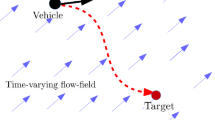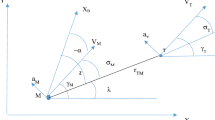Abstract
A ship/boat is travelling parallel to a river bank and a patrol vehicle is approaching the river along a road perpendicular to the river bank, i.e., the ship and the vehicle are moving at right angles to each other with uniform speeds. The patrol vehicle focuses a search light on the ship at all time instants, implying continuous rotation of the search light beam. In this article the relative velocity and acceleration between the ship and the vehicle as well as the angular velocity and acceleration of the beam are determined. Some numerical examples are also cited.
Similar content being viewed by others
Suggested Reading
David R Duncan and Bonnie H Litwiller, Related Time Rates: Comparing Angular and Linear Velocity, Mathematics Teacher, Vol.43, No.3 and 4, pp.193–195, 2007.
M Ray and G C Sharma A Textbook on Dynamics, SChand and Company Ltd., New Delhi 110055, pp. 21–24, 2000.
Author information
Authors and Affiliations
Corresponding author
Rights and permissions
About this article
Cite this article
Maitra, S.N. Minimum linear velocity and maximum angular velocity in a pursuit problem: Use of calculus. Reson 17, 505–511 (2012). https://doi.org/10.1007/s12045-012-0055-2
Published:
Issue Date:
DOI: https://doi.org/10.1007/s12045-012-0055-2




